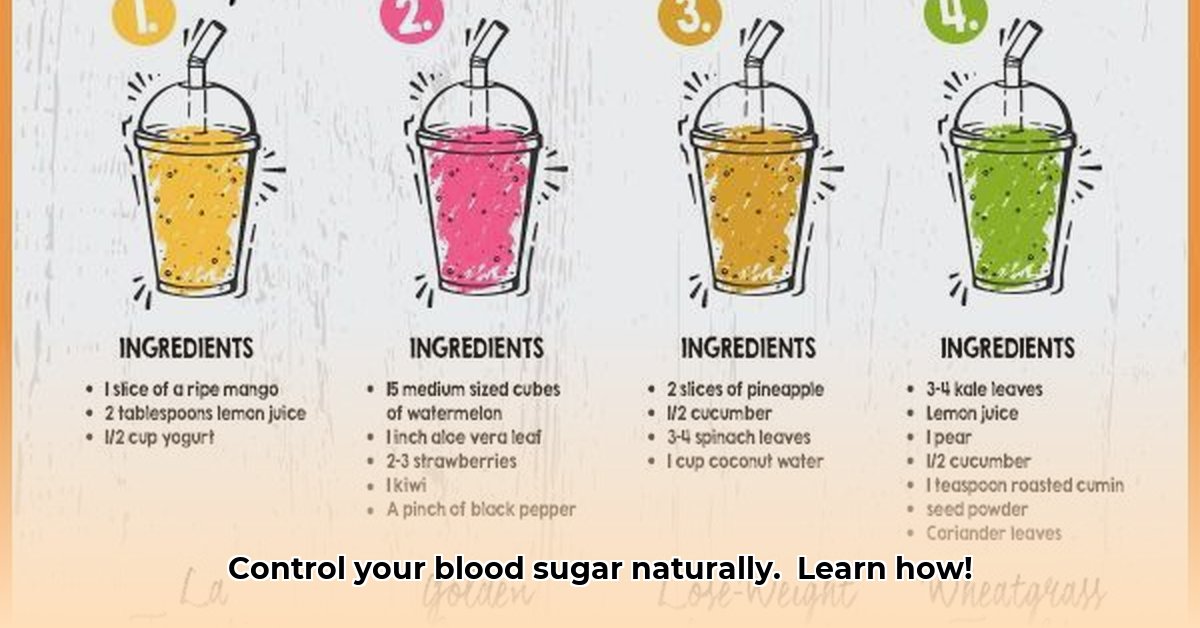
Juicing for Diabetes: A Comprehensive Guide
Living with diabetes requires careful management of blood sugar levels. While juicing isn't a cure-all, incorporating carefully selected juices into a balanced diet may offer benefits for weight management and overall well-being. This guide provides delicious and effective recipes, but remember: always consult your doctor or registered dietitian before making significant dietary changes. They can help you personalize a plan that's safe and effective for your individual needs.
Understanding the Power of Juicing for Diabetes
Many people with diabetes are hesitant about juicing due to concerns about sugar content. However, the key lies in strategic ingredient selection. Focusing on low-glycemic-index (GI) vegetables and limiting high-GI fruits can mitigate these risks. Low-GI foods release sugar slowly into the bloodstream, preventing the sharp spikes associated with high-GI options. Could juicing, done correctly, become a valuable part of your diabetes management strategy?
Building Your Diabetic-Friendly Juice Arsenal
Choosing the right ingredients is paramount. Here's a shopping list to guide your juicing journey:
- Low-GI Powerhouses: Leafy greens (kale, spinach), cucumber, celery, bell peppers are exceptional choices.
- Use Sparingly: Berries (strawberries, blueberries), and a small amount of citrus fruits can be incorporated cautiously.
- Proceed with Caution: High-GI fruits like bananas, mangoes, and grapes should be avoided or used in extremely small quantities due to their rapid impact on blood sugar.
Remember to check the glycemic index of specific fruits and vegetables, as values can vary depending on ripeness and preparation methods. Reliable online resources and nutrition databases can be helpful in this regard.
Delicious and Effective Diabetic-Friendly Juice Recipes
The following recipes provide a starting point. Remember to adjust portion sizes according to your individual needs and always monitor your blood sugar levels before and after consuming these juices.
Recipe 1: The Green Goodness Blast
This recipe is packed with nutrients and low in sugar.
Ingredients:
- 1 cup kale (thoroughly washed)
- ½ cup spinach (washed)
- 1 cucumber (peeled and chopped, optional)
- ½ cup celery (chopped)
- ½ lemon (juiced)
- 1-inch piece of ginger (peeled, optional)
Instructions:
- Wash all ingredients thoroughly.
- Combine all ingredients in a juicer.
- Enjoy immediately.
Recipe 2: The Carrot Sunshine Zing
This recipe offers a slightly sweeter option, while still being mindful of blood sugar levels.
Ingredients:
- 2 large carrots (peeled and chopped)
- ½ cup 100% orange juice (use sparingly)
- 1 small beet (optional)
- ¼ cup parsley
Instructions:
- Wash and prepare ingredients.
- Juice all ingredients.
- Enjoy immediately.
Crucial Considerations for People with Diabetes
- Blood Sugar Monitoring: Regularly check your blood sugar levels before and after consuming juices to monitor your body's response.
- Portion Control: Even healthy juices should be consumed in moderation as part of a balanced diet.
- Medical Consultation: Always consult your doctor or registered dietitian before making significant dietary changes, especially if you're on diabetes medication.
- Fiber Intake: Since juicing removes fiber, ensure you're consuming plenty of fiber-rich foods throughout the day to regulate blood sugar.
Weighing the Pros and Cons: Juicing and Diabetes Management
Juicing offers potential benefits, but it's crucial to understand its limitations:
| Pros | Cons |
|---|---|
| Increased nutrient intake | Significant fiber loss |
| Potential aid in weight loss | Risk of blood sugar spikes if ingredients aren't carefully chosen |
| Enhanced satiety | Requires careful planning and moderation |
| Convenient and refreshing option | Not a replacement for a balanced diet and medical care |
| May contribute to overall well-being | Potential interactions with some diabetes medications |
Remember, juicing is one component of a holistic diabetes management strategy. A balanced diet, regular exercise, consistent medical supervision, and medication adherence (if prescribed) are vital. Juicing, when done responsibly, can be a supplementary tool in your overall approach.
By following these guidelines and consulting with your healthcare providers, you can safely and effectively incorporate juicing into your healthier lifestyle.